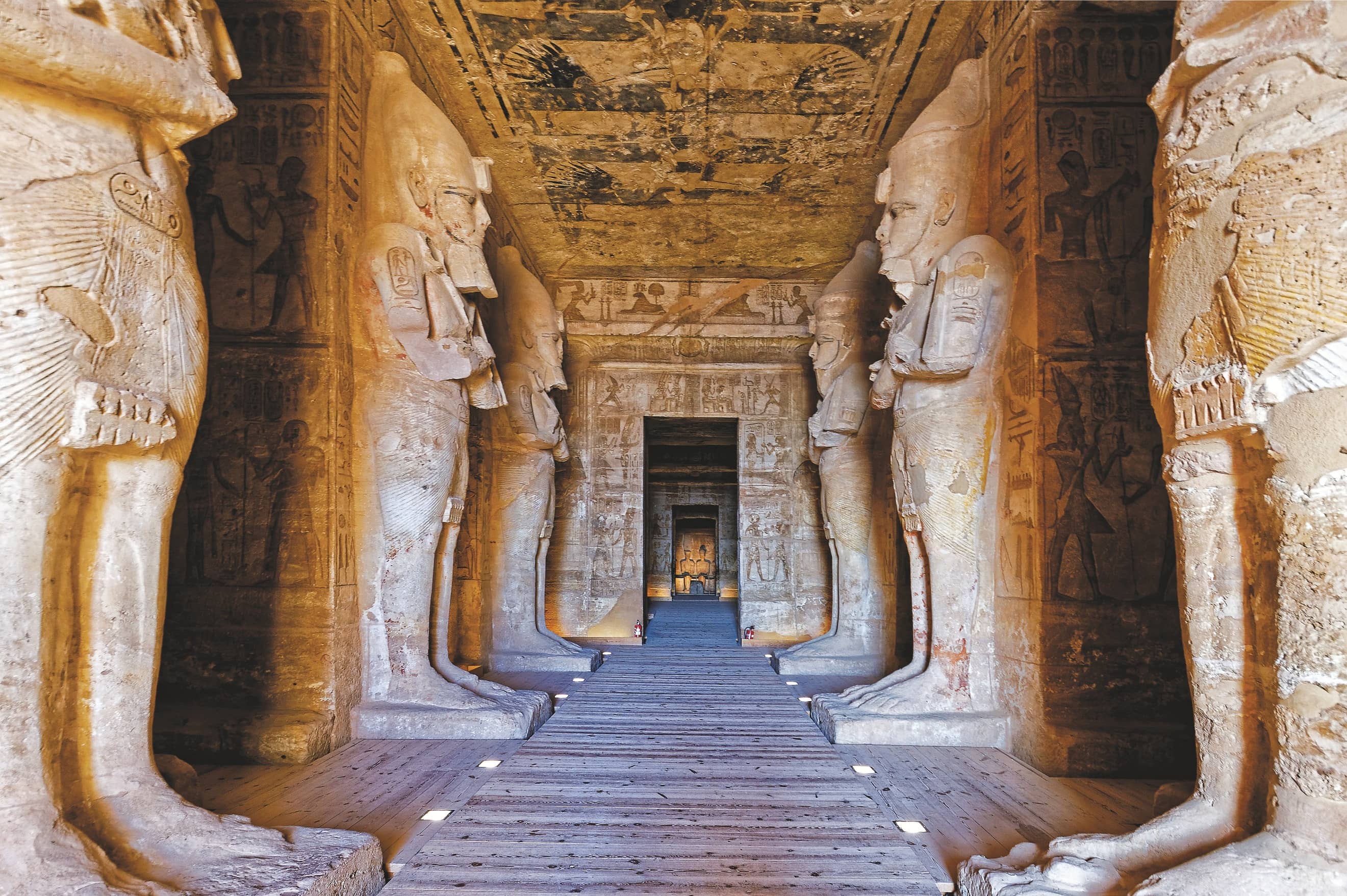
The Great and Small Temples at Abu Simbel – 230 kilometres south of the Egyptian town of Aswan – caught the imagination of the world when they were cut into blocks and moved on to high ground above the rising waters of Lake Nasser between 1964 and 1968.
Today, these magnificent rock-cut temples attract many thousands of visitors each year, but the iconic Great Temple went unnoticed by the earliest European explorers, who visited only the Small Temple nearer to the Nile’s western bank. The Swiss-born explorer Johann Ludwig Burckhardt (1784-1817) – who had previously rediscovered the Nabataean city of Petra in 1812 – found the barest tops of the colossal statues that flank the entrance purely by accident. His journal entry of 22 March 1813 records the event:
Having, as I supposed, seen all the antiquities of Ebsambal [Abu Simbel], I was about to ascend the sandy side of the mountain… when having luckily turned more to the southward, I fell in with what is yet visible of four immense colossal statues cut out of the rock… they are now almost entirely buried beneath the sands, which are blown down here in torrents.
After making further notes, Burckhardt continued his explorations – heading further south and then east to Mecca and Medina – and it was not until 19 June 1815 that he returned to Cairo. At some point afterwards, Burckhardt made the acquaintance of the Paduan showman turned water-engineer Giovanni Battista Belzoni (17781823). When Belzoni was commissioned by the British consul Henry Salt (1780-1827) to retrieve a colossal head of the ‘Young Memnon’ (now a centrepiece of the British Museum) from the west bank of the Nile near Luxor, he took advantage of a lull in the proceedings to head south to Abu Simbel, arriving on 8 September 1816.
This story is from the September/October 2020 edition of Minerva.
Start your 7-day Magzter GOLD free trial to access thousands of curated premium stories, and 8,500+ magazines and newspapers.
Already a subscriber ? Sign In
This story is from the September/October 2020 edition of Minerva.
Start your 7-day Magzter GOLD free trial to access thousands of curated premium stories, and 8,500+ magazines and newspapers.
Already a subscriber? Sign In

ROMAN DISCOVERIES AT ANCIENT AUGUSTODUNUM
More than 230 graves have been uncovered at a necropolis in the French city of Autun, revealing a diverse mix in burial practices over a period of nearly 200 years, as well as luxury grave goods from the 3rd and 4th centuries AD that highlight the wealth of some of its ancient inhabitants.

SHAPING THE WORLD: SCULPTURE FROM PREHISTORY TO NOW
The sculptor Antony Gormley and the art historian and critic Martin Gayford have been talking about sculpture with each other for 20 years.

Amelia Edwards (1831-1892)
“I am essentially a worker, and a hard worker, and this I have been since my early girlhood.”

THE GREAT BEYOND
The ancient Greeks thought much about the dead – how their remains should be disposed of, how their spirits might be summoned, how malignant they could be if unavenged. Classicist David Stuttard brings us face to face with the Greek dead.

INTO THE VALLEY OF THE QUEENS
The Great Royal Wife of Ramesses II, Nefertari, was buried in one of the most spectacular tombs of Egypt’s Valley of the Queens. Well-educated and well-travelled, Nefertari played a crucial part in the political life of the pharaoh, and her importance was reflected through her magnificently decorated tomb. Lucia Marchini speaks to Jennifer Casler Price to find out more.

DEIR EL-BAHRI, 1894
Tensions were already high among the archaeologists, surveyors, and artists of the Archaeological Survey of Egypt in 1891 when an eventful dispute arose on Christmas Eve.

PUSHING BOUNDARIES
When the Etruscans expanded to the south and the vast plains of Campania, they found a land of cultural connections and confrontations, as luxurious grave goods found across the region reveal. An exhibition at the National Archaeological Museum in Naples sheds light on these ancient Italians at the frontier. Paolo Giulierini, director of the museum, is our guide.

CUZCO 'CENTRE AND HEAD OF ALL THE LAND'
Cuzco was the heart of the vast Inca empire, but all changed in the 16th century when the capital was conquered by Spanish invaders. Michael J Schreffler investigates the Inca city, and how it went from the centre of one empire to the periphery of another.

A STUDY IN PURPLE
A tiny speck of purple paint from the 2nd century AD may yield clues to how ancient artists created the extraordinary portrait panels that accompanied mummified bodies into the afterlife.

Rome In The 8th Century: A History In Art
John Osborne CAMBRIDGE UNIVERSITY PRESS, £75 HARDBACK - ISBN 978-1108834582